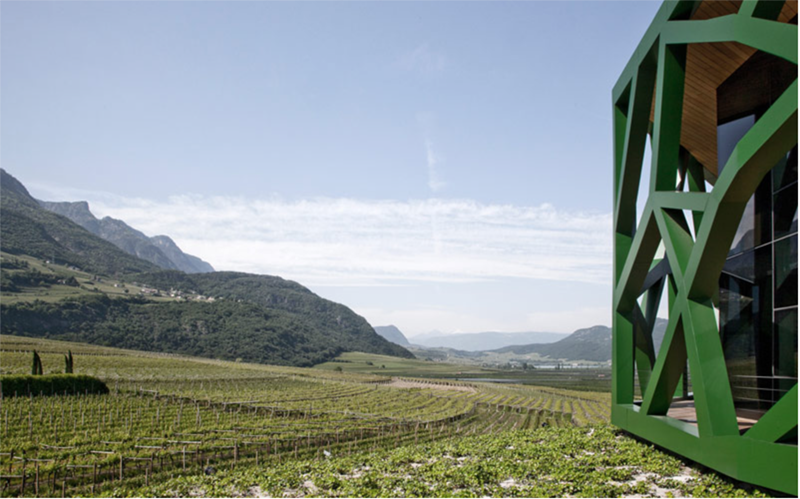Italy isn’t a very large country.1 But, geography creates huge diversity among its wine regions. And Alto Adige - Südtirol is also one of Italy’s most extreme growing areas.
Alto Adige - Südtirol is the northernmost region in Italy, immediately south of Austria and west of Switzerland. It lies in the Alps mountain range. The mountains strongly affect the topography, climate, and which grapes can thrive there.
The proximity of Alto Adige - Südtirol to Austria is obvious not just on maps, but in the language, architecture, and food. German is an official language there, even dominant. And, at dinner, you're more likely to find schnitzel and spätzle than pasta or risotto.
Alto Adige - Südtirol Climate & Principal Grapes
The mountains protect Alto Adige - Südtirol from very cold weather and rain that might otherwise come in from the north. But, at 600-3,300 feet, sheer altitude keeps daily temperatures from getting very high and also brings substantial cooling at night. The average temperature during the growing season is just 64°.
Despite getting plenty of sun, the cool weather means Alto Adige - Südtirol is primarily a white wine region. 62% of its vineyard acres are devoted to white varieties.
| Grape Variety | Percentage of Acres |
| Pinot Grigio | 11.9 |
| Gewürtztraminer | 10.8 |
| Pinot Bianco | 10.2 |
| Chardonnay | 10.1 |
| Sauvignon Blanc2 | 7.8 |
| Müller-Thurgau | 3.6 |
| Kerner | 1.9 |
| Moscato Giallo | 1.7 |
| Riesling | 1.6 |
| Sylvaner | 1.3 |
| Grüner Veltliner | 0.5 |
Note that these grapes are not always made into varietal wines. There are delicious blends too, sometimes made from unexpected combinations. For example, some producers combine Sauvignon Blanc, Chardonnay, and Pinot Bianco. Another great example is the 2016 Tramin Stoan (available at JJ Buckley), which includes those three grapes, plus Gewürtztraminer. It's rated at 94 points by both Wine Advocate and James Suckling.

Alto Adige - Südtirol takes great pride in its white wines. And cool climate, excellent terroir, and skilled winemaking can lead to wines of stunning beauty and even ageability. Most of the whites sell for less than $40, but there are a few icons that go for well over $100.
The most important red grapes are two autochthonous3 varieties: Schiava (12.6%) and Lagrein (8.8%). They are followed by two extremely popular, international reds that can do well in moderately cool areas: Pinot Nero (8.6%) and Merlot (3.5%). Which grapes are planted where depends on the mesoclimate and soils of particular zones or vineyards.

Alto Adige - Südtirol Size & Recognized Regions
Alto Adige - Südtirol is not a massive growing region. It holds just 13,529 planted acres. That's just 75% the vineyard land of Chianti Classico. Alto Adige - Südtirol's focus on white wines allows it to produce more gallons of wine than Chianti Classico.
Alto Adige - Südtirol makes just 1% of Italy's wine. However, a higher percentage of its wine is at the DOC level than any other main growing area.
The primary appellation for the area is Alto Adige DOC. There are also seven more specific DOC.
Alto Adige Valle Isarco DOC aka Eisacktaler DOC
Alto Adige Meranese DOC
Alto Adige Colli di Bolzano DOC
Alto Adige Santa Maddalena DOC
Alto Adige Val Venosta DOC
Alto Adige Terlano DOC
Lago di Caldero DOC aka Kalterersee DOC
Some Italian regions have a strong export focus. Alto Adige - Südtirol, though, only sends one-third of its wine abroad. The top three export markets are Germany, the United States and Switzerland.
1 The entire country of Italy has just 70% the land mass of California.
2 Sauvignon Blanc from Alto Adige - Südtirol is often labelled just "Sauvignon"
3 Autochthonous refers to grapes that are indigenous to a particular area and not grown in any significant amount elsewhere.
Images courtesy of Cantina Tramin.
JJ Buckley guest blogger Fred Swan is a San Francisco-based wine writer, educator, and authority on California wines and wineries. His writing appears in The Tasting Panel, SOMM Journal, GuildSomm.com, Daily.SevenFifty.com, PlanetGrape.com, and his own site, FredSwan.Wine (formerly NorCalWine). He teaches at the San Francisco Wine School. He's founder of Wine Writers' Educational Tours, an annual, educational conference for professional wine writers. He also leads private wine tours and conducts tastings and and seminars. Fred’s certifications include WSET Diploma, Certified Sommelier, California Wine Appellation Specialist, Certified Specialist of Wine, French Wine Scholar, Italian Wine Professional, Napa Valley Wine Educator, Northwest Wine Appellation Specialist, and Level 3 WSET Educator. He's been awarded a fellowship by the Symposium for Professional Wine Writers three times.